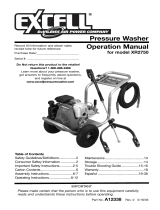
4- ENG
DANGER: RISK TO BREATHING (ASPHYXIATION)
WHAT CAN HAPPEN HOW TO PREVENT IT
• Breathing exhaust fumes will cause
serious injury or death! Engine
exhaust contains carbon monoxide,
an odorless and deadlygas.
• Operate pressure washer in a well-
ventilated area. Avoid enclosed areas
such as garages, basements,etc.
• Never operate unit in or near a location
occupied by humans oranimals.
• Some cleaning fluids contain
substances which could cause injury
to skin, eyes orlungs.
• Use only cleaning fluids specifically
recommended for high pressure washers.
Follow manufacturers recommendations.
Do not use chlorine bleach or any other
corrosive compound.
DANGER: RISK OF FLUID INJECTION AND LACERATION
WHAT CAN HAPPEN HOW TO PREVENT IT
• Your pressure washer operates at fluid
pressures and velocities high enough
to penetrate human and animal flesh
which could result in amputation or
other serious injury. Leaks caused
by loose fittings or worn or damaged
hoses can result in injection injuries.
DO NOT TREAT FLUID INJECTION
AS A SIMPLE CUT! See a physician
immediately!
• Inspect the high pressure hose regularly.
Replace the hose immediately if it is
damaged, worn, has melted from
contacting the engine, or shows any signs
of cracks, bubbles, pinholes, or other
leakage. Never grasp a high pressure
hose that is leaking ordamaged.
• Never touch, grasp or attempt to cover
a pinhole or similar water leak on the
high pressure hose. The stream of
water IS under high pressure and WILL
penetrateskin.
• Never place hands in front ofnozzle.
• Direct spray away from self andothers.
• Make sure hose and fittings are tightened
and in good condition. Never hold onto
the hose or fittings duringoperation.
• Do not allow hose to contactmuffler.
• Never attach or remove wand or hose
fittings while system ispressurized.
• When using replacement lances or guns
with this pressure washer, DO NOT use
a lance and/or lance/gun combination
that is shorter in length than what was
provided with this pressure washer as
measured from the nozzle end of the
lance to the guntrigger.
• Injuries can result if system pressure
is not reduced before attempting
maintenance ordisassembly.
• To relieve system pressure, shut off
engine, turn off water supply and pull gun
trigger until water stopsflowing.
• Use only accessories rated equal
to or higher than the rating of the
pressurewasher.























